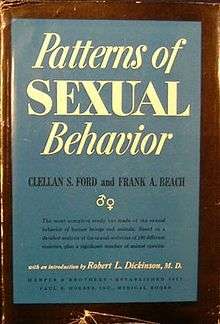Patterns of Sexual Behavior
 Cover of the first edition | |
| Author |
Clellan S. Ford Frank A. Beach |
|---|---|
| Country | United States |
| Language | English |
| Subject | Sexual behavior |
| Publisher | Harper & Brothers |
Publication date | 1951 |
| Media type | Print (hardcover and paperback) |
| Pages | 330 (1965 edition) |
| ISBN | 978-0061319136 |
Patterns of Sexual Behavior, published in 1951, is a work of scientific literature co-authored by Clellan S. Ford and Frank A. Beach. The book integrates information about human sexual behavior from 191 different cultures, and includes detailed comparisons across animal species, with particular emphasis on primates.[1] Patterns of Sexual Behavior, which has been called a "classic" of its field,[2] provided the intellectual foundation for the later research of Masters and Johnson.[1]
Publication history
Patterns of Sexual Behavior was originally published by Harper & Brothers, New York in 1951.[3] The following year, the work was reprinted (under the title Patterns of Sexual Behaviour) by Eyre and Spottiswoode in London.[3] Metheun published a reprint of the 1951 Harper & Row edition in 1965.[3] In 1977, Frank Beach authored a revised version of the book, entitled Human Sexuality in Four Perspectives.[4]
Content
Patterns of Sexual Behavior employs a "cross-cultural correlational method" in exploring sexual behavior,[1] a statistical approach suitable for distinguishing behavioral trends and making generalizations.[1] The book integrates information from 191 cultures: 48 from Oceania, 28 from Eurasia, 33 from Africa, 57 from North America, and 26 from South America.[5] Much of their data was collected in the Human Relations Area Files,[1] a cross-institutional organization co-founded by Ford.[2] The comprehensive book offers information on such topics as "sexual positions, length (time) of intercourse, locations for intercourse, orgasm experiences, types of foreplay, courting behaviors, frequencies of intercourse [and] methods of attracting a partner."[3] The book covers homosexuality in both humans and other animals, citing evidence of accepted homosexual behavior in 49 of the 76 cultures for which the relevant data were available.[5] Ford and Beach conclude that there is a "basic mammalian capacity" for same-sex behavior.[5]
Reception
Patterns of Sexual Behavior has been described as a "classic" of its field.[2] Released in 1951, between the two volumes of the Kinsey Reports, the book was highly influential in the study of sexual behavior, and provided the intellectual foundation for the later research of Masters and Johnson.[1] The study is credited with "making homosexual behavior more visible and more acceptable within the culture of its time."[5]
Criticism
Despite being comprehensive for its time, Patterns of Sexual Behavior nevertheless contained a number of self-imposed limitations. Ford and Beach limited their definition of sexual behavior to "behavior involving stimulation and excitation of the sexual organs,"[5] and made no attempt to explore sexual symbolism.[5] While acknowledging that their study might have implications for psychology and psychoanalysis, Ford and Beach felt themselves unqualified to explore specific questions pertaining to this field.[5] The authors claimed to make no judgements of moral value, though their study is considered supportive of sexual relativism.[5]
References
- 1 2 3 4 5 6 Anne Bolin & Patricia Whelehan (1999), Perspectives on human sexuality, SUNY Press, p10
- 1 2 3 George P. Murdock (1974) "Clellan Stearns Ford, 1909-1972," American Anthropologist, New Series, Vol. 76, No. 1 (Mar., 1974), pp. 83-85
- 1 2 3 4 Patricia Stuart-Macadam & Katherine A. Dettwyler (1995) Breastfeeding: biocultural perspectives, Transaction Publishers, p207
- ↑ Dewsbury, Donald A. (2000) "Frank A. Beach, Master Teacher," Portraits of Pioneers in Psychology, Volume 4, p269-281
- 1 2 3 4 5 6 7 8 Andrew Paul Lyons & Harriet Lyons (2004) Irregular connections: a history of anthropology and sexuality, University of Nebraska Press, p268-70